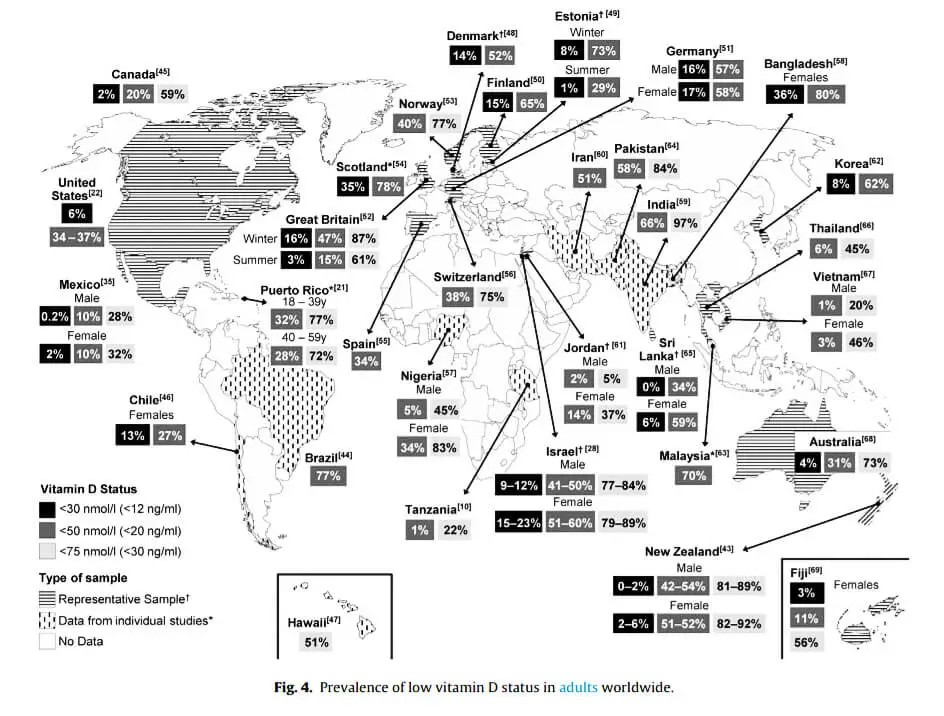Vitamin D- More than just your bones
Vitamin D is not a vitamin. It is a prohormone, a steroid with a hormone-like activity that regulates about 3% of the human genome.
Milos Pokimica
Written By: Milos Pokimica
Medically Reviewed by: Dr. Xiùying Wáng, M.D.
Updated June 9, 2023For most of our evolution, we were slim in a state of constant hunger and constant physical activity, naked (meaning exposed to the sun with excessive vitamin D production), and eating mostly vegan food. This was the case for all of our ancestor species and that means the time period of 50 million years. Adaptation is the development that the organism goes through in order to become accustomed to an environment. It is linked to evolution because it is a long process. One that occurs over many generations. Genetic change is what occurs. The genetic change that is the result of successful adaptation will always be beneficial to an organism. For example, before snakes slithered, they had regular limbs. They were similar to lizards. In order to fit into small holes in the ground in which they could hide from predators, they lost their legs. It may also happen that the environment changes very little and that species do not need to adapt at all. Examples of this can be seen in so-called living fossils like jellyfish that evolved 550 million years ago or nautilus marine mollusks that remained largely unchanged for 500 million years. Biologists say that the oldest living animals in the world today are ctenophores that first emerged 700 million years ago. Also, variations in the habitat may happen almost immediately, resulting in species growing less and less well adapted and eventually going extinct.
It has been theorized that dark skin pigmentation was the original condition for the genus Homo, including Homo sapiens (Jablonski et al., 2017). The problem arose when Homo sapiens moved into areas of low UV radiation. Light skin pigmentation is nothing more than a coping mechanism for our bodies for constant vitamin D shortages. Vitamin D is an essential vitamin with different functions, and only one of them is calcium development. On another hand, the light-skinned individuals who will go back to live near the equator will have an increased risk of folate depletion. Folate depletion is associated with numerous types of cancers, especially skin cancer, DNA damage, and congenital disabilities. Just entering a plane to go to a habitat that we are not adapted for and doing activities like sunbathing on the beach can cause the risk of skin cancer. It would be a good idea to drink beet juice while you are on vacation. It has the highest level of folate from all other food sources and folate is not the same substance as folic acid. Supplements have folic acid, and plants have folate. When they tested folic acid on rats their livers were able to convert folic acid into folate without any problems but we are not rats, and our liver is only able to convert a maximum of 400mg a day, so go with the beets and one 400 mg tablet.
When it comes to skin color, three separate genes produce light skin. European and also East Asian skin evolved to be much lighter only during the last 8000 years. The first modern humans to initially settle in Europe about 40,000 years ago are presumed to have had dark skin. Dark skin is beneficial in the sunny climate of Africa. Early hunter-gatherers around 8500 years ago, in Spain, and central Europe also had darker skin. Only in the far north where there are low light levels the environment will favor pale skin.
When we look at the fossil record, then there is a different picture of hunter-gatherers in the far north. When examined all of the seven people from the 7700-year-old Motala archaeological site in southern Sweden (so-called “Tomb of the Sunken Skulls”), all had light skin gene variants (Günther et al., 2018). They also had a specific gene, HERC2/OCA2, which is responsible for blond hair, pale skin, and blue eyes.
Around 8000 years ago in the far north ancient hunter-gatherers were pale and blue-eyed, but still, all of those people living in central and southern Europe still had darker skin. It was only after the first farmers from the Near East arrived in Europe that the situation changed. They carried genes for light skin. As they have been interbreeding and mixing with the indigenous dark-skinned hunter-gatherers, one of their light-skin genes swept through Europe presumably because of the favorable environmental conditions that lack the sunny climate of Africa. It was only around 8000 years ago that people from the central and southern parts of Europe started to have lighter skin. Lack of sun, especially during winter, forced the adaptation and so natural selection has favored genetic adaptations to that problem by a paling of the skin that absorbs UV more efficiently. The second line in adaptations to colder climates was also a favoring of lactose tolerance. Vitamin D can be naturally found in some amount of regular milk.
Vitamin D is not a vitamin. It is a prohormone, a steroid with a hormone-like activity that regulates about 3% of the human genome from calcium metabolism, muscular function, immune system regulation, and many more functions that are essential for life. (Carlberg, 2019).
The current medical knowledge associates vitamin D deficiency with contributing to the development of seventeen different autoimmune diseases, periodontal disease, cancers, congenital disabilities, stroke, and heart disease. Vitamin D insufficiency and in worse cases even deficiency is a problem that has spread to the global level now. And why? Because we changed our habitat and started to wear clothes. If you are a Muslim woman in a Sharia law country, it does not matter if you live in a sunny climate. If you are a black African and you start to live the modern way of life, meaning spending most of your time indoors, and in cars wearing t-shirts and pans you will be vitamin D deficient. Despite substantial daily sunlight availability in Africa and the Middle East, people living in these regions are often vitamin D insufficient or deficient ranging from 5% to 80%. Vitamin D insufficiency is rampant among African Americans. Even young, healthy blacks do not achieve optimal concentrations at any time of the year.

White people are more adept to the northern climate. Black people are more adept at the southern latitudes. Well at least before the Modern Era. Now we are not adapted to any climate. Why? Because we do not run naked not even during the summer, so we do not get any vitamin D for most of the year. We live indoors. Even being naked and exposed to the sunlight during summer was not enough for the northern geographical latitudes to sustain adequate vitamin D levels for the entire year around. Our physiology is adapted by paling our skin. Modern technology-driven conditions are 10-times worst. In the future probably we will all have albinism as a result of adaptation if nothing is changed.
Groups of Neanderthals were pale too. Some of them had more pigment, some less, and some were pale and had red hair.
If you do not believe this, we will go scientific. There is the receptor that activates melanin, the pigment that gives skin, hair, and eyes their color. It is known as melanin-activating peptide receptor melanocortin 1 (MC1R). It is present on the surface of melanocytes (cells that produce melanin). Melanocytes can make two different types of melanin. One is called eumelanin, and the other is pheomelanin. MC1R is a receptor that will decide which pigment will be produced. It acts as a switch. It will decide whether will it be red-and-yellow pigment pheomelanin or black-and-brown pigment eumelanin. In one genetic study, the scientific team led by Holger Römpler of Harvard University extracted and sequenced the MC1R gene from the bones of a 43,000-year-old Neanderthal from El Sidrón, Spain, and a 50,000-year-old one from Monti Lessini, Italy (Lalueza-Fox et al., 2007). The two Neanderthal samples both showed a point mutation that is not present in modern humans. If such a mutation is induced in human cells, it will cause impaired MC1R activity. The mutation would cause red hair and pale skin in modern humans. To make sure that the MC1R gene mutation was not due to contamination of the sample from modern humans, the scientists tested around 4,000 people. None of the people tested had it. This genetic study showed that both Homo sapiens and Neanderthal had reached the same genetic adaptation by two different evolutionary pathways. Anthropologists had predicted a long time ago that due to the environment Neanderthals might have evolved to have pale skin. The work by Römpler and colleagues offers the first scientific evidence to support this thesis. So it is not that we inherited the blond gene from Neanderthals it is that evolution works similarly in similar conditions. When Neanderthals went into northern climates adaptation did the rest.
Today we have modern technology, an indoor lifestyle, and all of the rest of the fancy new changes in the habitat that are not congruent with our physiology, and health problems will occur as a consequence of maladaptation.
References:
- Jablonski, N. G., & Chaplin, G. (2017). The colours of humanity: the evolution of pigmentation in the human lineage. Philosophical Transactions of the Royal Society B, 372(1724), 20160349. https://doi.org/10.1098/rstb.2016.0349
- Günther, T., Malmström, H., Svensson, E. M., Omrak, A., Sánchez-Quinto, F., Kılınç, G. M., Krzewińska, M., Eriksson, G., Fraser, M., Edlund, H., Munters, A. R., Coutinho, A., Simões, L. G., Vicente, M., Sjölander, A., Jansen Sellevold, B., Jørgensen, R., Claes, P., Shriver, M. D., Valdiosera, C., … Jakobsson, M. (2018). Population genomics of Mesolithic Scandinavia: Investigating early postglacial migration routes and high-latitude adaptation. PLoS biology, 16(1), e2003703. https://doi.org/10.1371/journal.pbio.2003703
- Carlberg C. (2019). Nutrigenomics of Vitamin D. Nutrients, 11(3), 676. https://doi.org/10.3390/nu11030676
- Lalueza-Fox, C., Römpler, H., Caramelli, D., Stäubert, C., Catalano, G., Hughes, D., Rohland, N., Pilli, E., Longo, L., Condemi, S., de la Rasilla, M., Fortea, J., Rosas, A., Stoneking, M., Schöneberg, T., Bertranpetit, J., & Hofreiter, M. (2007). A melanocortin 1 receptor allele suggests varying pigmentation among Neanderthals. Science (New York, N.Y.), 318(5855), 1453–1455. https://doi.org/10.1126/science.1147417
- Palacios, C., & Gonzalez, L. (2014). Is vitamin D deficiency a major global public health problem?. The Journal of steroid biochemistry and molecular biology, 144 Pt A, 138–145. https://doi.org/10.1016/j.jsbmb.2013.11.003
Do you have any questions about nutrition and health?
I would love to hear from you and answer them in my next post. I appreciate your input and opinion and I look forward to hearing from you soon. I also invite you to follow us on Facebook, Instagram, and Pinterest for more diet, nutrition, and health content. You can leave a comment there and connect with other health enthusiasts, share your tips and experiences, and get support and encouragement from our team and community.
I hope that this post was informative and enjoyable for you and that you are prepared to apply the insights you learned. If you found this post helpful, please share it with your friends and family who might also benefit from it. You never know who might need some guidance and support on their health journey.
– You Might Also Like –

Learn About Nutrition
Milos Pokimica is a doctor of natural medicine, clinical nutritionist, medical health and nutrition writer, and nutritional science advisor. Author of the book series Go Vegan? Review of Science, he also operates the natural health website GoVeganWay.com
Medical Disclaimer
GoVeganWay.com brings you reviews of the latest nutrition and health-related research. The information provided represents the personal opinion of the author and is not intended nor implied to be a substitute for professional medical advice, diagnosis, or treatment. The information provided is for informational purposes only and is not intended to serve as a substitute for the consultation, diagnosis, and/or medical treatment of a qualified physician or healthcare provider.NEVER DISREGARD PROFESSIONAL MEDICAL ADVICE OR DELAY SEEKING MEDICAL TREATMENT BECAUSE OF SOMETHING YOU HAVE READ ON OR ACCESSED THROUGH GoVeganWay.com
NEVER APPLY ANY LIFESTYLE CHANGES OR ANY CHANGES AT ALL AS A CONSEQUENCE OF SOMETHING YOU HAVE READ IN GoVeganWay.com BEFORE CONSULTING LICENCED MEDICAL PRACTITIONER.
In the event of a medical emergency, call a doctor or 911 immediately. GoVeganWay.com does not recommend or endorse any specific groups, organizations, tests, physicians, products, procedures, opinions, or other information that may be mentioned inside.
Editor Picks –
Milos Pokimica is a health and nutrition writer and nutritional science advisor. Author of the book series Go Vegan? Review of Science, he also operates the natural health website GoVeganWay.com
Latest Articles –
Top Health News — ScienceDaily
- Why consciousness exists at allon December 15, 2025
Consciousness evolved in stages, starting with basic survival responses like pain and alarm, then expanding into focused awareness and self-reflection. These layers help organisms avoid danger, learn from the environment, and coordinate socially. Surprisingly, birds show many of these same traits, from subjective perception to basic self-awareness. This suggests consciousness is far older and more widespread than once believed.
- AI found a way to stop a virus before it enters cellson December 15, 2025
Researchers discovered a hidden molecular “switch” that herpes viruses rely on to invade cells. By combining AI, simulations, and lab experiments, they identified and altered a single amino acid that shut down viral entry. What once might have taken years was achieved far faster using computational tools. The findings open new possibilities for designing future antiviral treatments.
- New study shows some plant-based diets may raise heart disease riskon December 15, 2025
Researchers tracking over 63,000 adults found that high-quality, minimally processed plant foods significantly reduce cardiovascular risk. But when those plant foods are ultra-processed, the advantage disappears—and can even backfire. Some ultra-processed plant diets increased risk by 40%. The study urges a shift toward whole, naturally nutrient-rich plant foods.
- These simple habits could make your brain 8 years younger, study findson December 15, 2025
New research shows that your brain’s “true age” can shift dramatically depending on how you live, with optimism, restorative sleep, stress management, and strong social support acting like powerful anti-aging tools. Using advanced MRI-based brain-age estimates, scientists found that people with multiple healthy lifestyle factors had brains up to eight years younger than expected — even among those living with chronic pain.
- Anxiety and insomnia linked to sharp drops in key immune cellson December 15, 2025
Natural killer cells act as the immune system’s rapid-response team, but the stress of anxiety and insomnia may be quietly thinning their ranks. A study of young women in Saudi Arabia found that both conditions were linked to significantly fewer NK cells—especially the circulating types responsible for destroying infected or abnormal cells. As anxiety severity increased, NK cell levels dropped even further, suggesting a stress-driven weakening of immune defenses.
- Cannabis compounds show unexpected power against ovarian canceron December 15, 2025
Scientists have discovered that key compounds from cannabis—CBD and THC—show surprisingly strong effects against ovarian cancer cells. Used together, they slow cell growth, reduce colony formation, and may even block the cancer’s ability to spread. Even more promising, the treatment caused minimal harm to healthy cells and appears to work by restoring a disrupted signaling pathway that fuels tumor growth.
- Mayo Clinic neurosurgeon reveals 8 back pain myths to stop believingon December 15, 2025
Back pain is wrapped in persistent myths, but many are far from the truth. From misconceptions about heavy lifting and bed rest to confusion over posture, exercise, and surgery, Dr. Meghan Murphy breaks down what really causes pain and what actually helps. Her insights reveal that everyday habits, movement, and smart prevention often make a bigger difference than people realize.
PubMed, #vegan-diet –
- Healthful and Unhealthful Plant-Based Diets and Their Association with Cardiometabolic Targets in Women Diagnosed with Breast Cancer: A Cross-Sectional Analysis of a Lifestyle Trialon December 11, 2025
CONCLUSIONS: Maintaining cardiometabolic risk factors within normal ranges is clinically relevant in BCS, and this may be more likely when a plant-based diet is consumed, especially if low in unhealthy plant foods.
- Dietary and Lifestyle Patterns and Their Associations with Cardiovascular and Inflammatory Biomarkers in Vegans, Vegetarians, Pescatarians, and Omnivores: A Cross-Sectional Studyon December 11, 2025
Background: Plant-based diets are associated with reduced cardiometabolic risk, yet the influence of lifestyle behaviors on these benefits remains insufficiently understood. Objective: To assess the combined impact of dietary patterns and lifestyle behaviors on body composition, lipid profiles, and inflammatory biomarkers in healthy young adults. Methods: In this cross-sectional study, 155 participants aged 18-39 years were categorized into four dietary groups: vegans (n = 48), vegetarians (n […]
- Functional and Nutritional Properties of Lion’s Mane Mushrooms in Oat-Based Desserts for Dysphagia and Healthy Ageingon December 11, 2025
Hericium erinaceus (Lion’s Mane mushroom) is a medicinal species recognised for its neuroprotective and antioxidant properties. This study investigated its potential as a functional ingredient in oat milk-based desserts formulated for individuals with dysphagia. Freeze-dried Lion’s Mane powder (LMP), containing high-quality protein (~16%, amino acid score 88%), dietary fibre (~31%), and phenolic compounds (72.15 mg GAE/g), was incorporated at varying levels using gelatin or iota-carrageenan […]
- “A football team with no midfield”: A qualitative analysis of anti-vegan stigma in Italyon December 7, 2025
A growing body of research has demonstrated the prevalence of unfavourable attitudes towards individuals who adhere to a vegan diet and has provided empirical evidence to support the existence of an anti-vegan ideology. The present study aims to contribute to extant knowledge by examining the social perception of veganism and vegans in Italy. Italy is a nation characterised by a traditional culture of food that serves as a significant catalyst for collective identification and national pride….
- Plant-based dietary index on the Mediterranean and a vegan diet: a secondary analysis of a randomized, cross-over trialon December 5, 2025
CONCLUSION: These findings suggest that, replacing animal products even with the “unhealthful” plant-based foods on a vegan diet was associated with weight loss.
Random Posts –
Featured Posts –
Latest from PubMed, #plant-based diet –
- Identification of effective plant-based oils for use in aquafeed: An evaluation of impact on gamete quality and developmental success using zebrafish (Danio rerio) as a screening organismby Seyed-Mohammadreza Samaee on December 14, 2025
To evaluate the effectiveness of zebrafish as a screening system for identifying appropriate plant oils (POs) for aquafeed, Artemia nauplii (AN) were enriched with three single- cultivar olive oils (OO): Koroneiki, Parseh, and Arghavan. The resulting AN (ANKor, ANPar, ANArg, and AN36 [36 h starved AN, control]) were then fed to 360 fish (3.5 cm) for one month. The fatty acid (FA) profile of the AN was reflected in the ova and influenced both sperm motility and density, which in turn affected […]
- The Effect of Dietary Interventions on Human Vascular Function in the Context of Acute Psychological Stress: A Scoping Reviewby Rosalind Baynham on December 14, 2025
Episodes of acute psychological stress increase the risk for cardiovascular diseases, partially through stress-induced impairments in vascular function. During psychologically stressful periods, individuals are more likely to consume unhealthy foods and fewer fruits and vegetables. Yet, the impact of dietary choices and their nutritional composition on vascular function in the context of psychological stress is unclear. In this scoping review, comprehensive database searches were carried out […]
- Plant-based diets, gut microbiota, blood metabolome, and risk of colorectal, liver and pancreatic cancers: results from a large prospective cohort study of predominantly low-income Americansby Fangcheng Yuan on December 14, 2025
CONCLUSIONS: A diet high in healthy plant foods and low in animal foods was inversely associated with liver cancer risk and with CRC risk among screening-naïve participants. These associations may be partly mediated through gut microbiota and systemic metabolism.
- Vegetarian diet and likelihood of becoming centenarians in Chinese adults aged 80 years or older: a nested case-control studyby Yaqi Li on December 14, 2025
CONCLUSIONS: Targeting individuals of advanced age (80+ years) in China, we found that individuals following vegetarian diet had lower likelihood of becoming centenarians relative to omnivores, underscoring the importance of a balanced high-quality diet with animal- and plant-derived food composition for exceptional longevity, especially in the underweight oldest-old.
- Priority of nutrition and exercise in depression management: triangulating mini-review of past and recent evidence with clinical practice guidelinesby Shannon Rogers on December 14, 2025
CONCLUSIONS: Disparities that exist in leading depression management guidelines vis-à-vis inclusion of evidence-informed nutrition and PA/PE recommendations, warrant reconciliation. Evidence supporting anti-depressant WFPB nutrition and limiting pro-inflammatory animal-sourced food and UPF and supporting anti-inflammatory aerobic exercise and resistance training warrants being translated into national/international depression management guidelines as consistently as recommendations for…
- The effect of a diet based on vegetable and dairy protein on biochemical and functional indicators of sarcopenia in patients with liver cirrhosis: a randomized controlled trialby Mahdiyeh Taghizadeh on December 13, 2025
CONCLUSIONS: In conclusion, a vegetable and dairy protein-based diet effectively inhibited significant elevations in ammonia levels compared to the standard diet in persons with liver cirrhosis; however, anthropometric parameters and muscle function did not differ between two groups.















